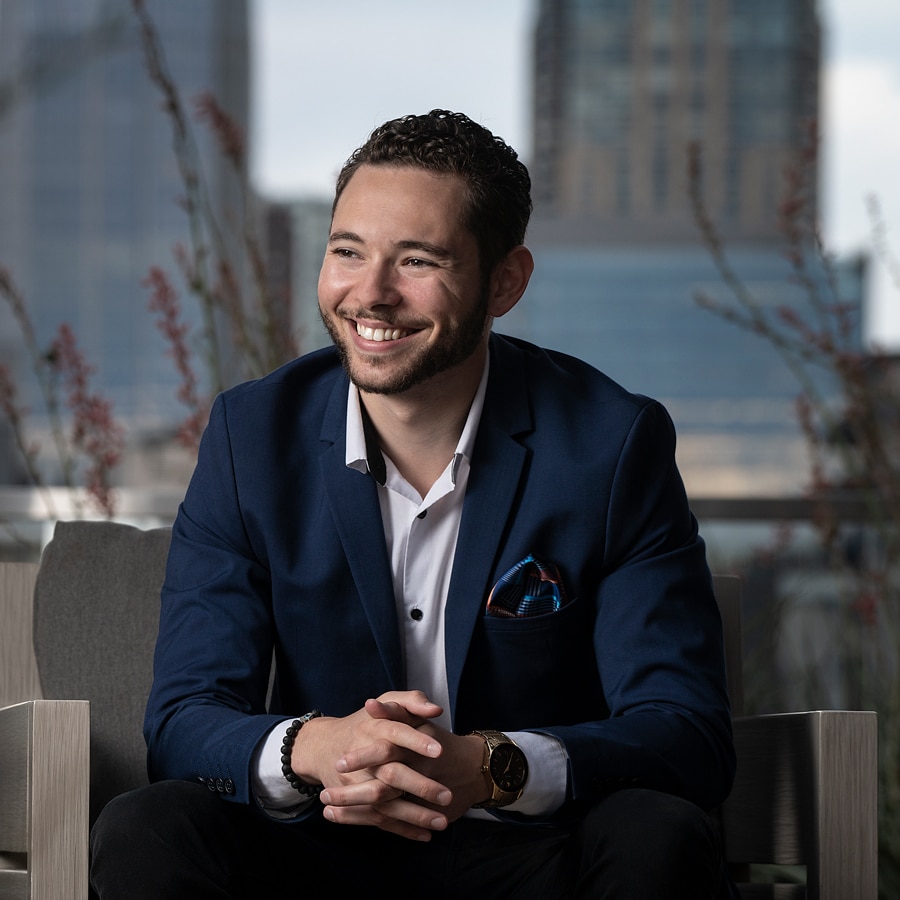
How to Have a Human-Focused Approach to Tech-Driven Business Development with Justin Scott
Relationships are the cornerstone to business development. And technology provides the vehicle to facilitate those relationships. But not all technology or business development approaches are created equal. On this episode of the B2B Mentors Podcast, we spoke with Justin Scott, VP & Founder of eLink about balancing technology and business, how to reign in the shiny object syndrome, the value of storytelling, strategies to create a steady stream of leads, and more.
A lot of entrepreneurs are either focused on technology development or business, but you’ve got this really great balance between the two. How have you refined that over the years?
[JS]: I am a serial entrepreneur. I have made a lot of mistakes over the years. I chased too many things. But through it all, I have balanced between the technology and business side of things. Throughout the process I failed a lot and succeeded as well. I think technology and business are both double-edged swords. The business side gave me more of the creative slant. It was the creative side that helped me interact with humans, whereas the technology was just that – technology. I have loved the journey, mistakes and all.
Probably the biggest thing I’ve learned from my mistakes along the way is to stop running at every single idea. When I’ve locked down and focused, I’ve had my best gains and biggest wins. The second thing is, I’m a bit of a fan of King Arthur and the Knights of the Round Table. I’ve often said I don’t want to be King Arthur, I want to be the knight to his left or his right that slays dragons.
I’ve never done it alone, and I guess that’s the point. I’ve always wanted to have people with me. When I have a new idea, I want to go on the journey with people. It’s far more fun for me.
That’s something I think most creative’s struggle with is that shiny object syndrome. Do you do anything in particular to reign that in so you can regain focus?
[JS]: From meditation to making lists, some of it has worked. Probably the biggest thing is acknowledging the shiny object but understanding and prioritizing the need to get stuff done. For me, making a list can really help. Whether it’s making a list for the day or week or month, I use these lists to set goals. My lists are the tasks or items I come back to every day to see what I was able to get done. I feel accomplished for the things I check off the list.
By managing your time and consistently looking at your list you can regain control and focus. Every time you look at your list and think “I want to take this off today” and then you go down a rabbit hole, you’ll come back an hour later unhappy that you’ve now lost that time and can’t get it back. It forces you through some pain to get a little focus.
Something you’ve had a pretty big focus on is media, marketing, and lead generation. What has been most exciting about that subject matter for you?
[JS]: The realization that you had to separate content and channel. Getting into that world with a business mindset. Any great story or visual will find its way to a consumer or reader of that content, so you need it to be focused. So many people get confused. They want to produce the content, and they want to produce it specific to a channel. But that’s not the right way to approach it. First, you need to tell good stories and/or produce good pictures, and then the channel will figure itself out. The channel moves. Today it may be Facebook, but it also could be Instagram, podcasts, or others. But the reality is, great storytelling will survive any channel.
Great stories do a couple of things. They are not just storytelling, they are marketing as well. If you get that storytelling right, it will evolve and find the right channel to market.
So I got excited about creating the content and knowing the storytelling, as well as chasing the new channels and figuring them out as they came along.
Why do you think most B2B marketers, business development leaders, business owners, and others struggle so much with storytelling?
[JS]: Two things. They think their stories are boring (and they are generally not, by the way). All of us have struggled through something and have a relatable story to tell. Our growth comes from struggle, and through that struggle and growth comes great stories. The second thing is it takes time and can feel quite time-consuming to create a great story. The market at the moment wants a quick story. They don’t want to spend the time to create a great story, they just want it now. They just want to create volume. There’s no quality in the storytelling or the content they are creating. That’s why they stay away from it. They’re scared. They don’t think what they have is great. So they look for someone else to provide a template that they can just change a few things and then use it. But they need to trust themselves more. There’s always a good story to tell — even if it’s only a two-liner.
What do you think has changed most in marketing and sales over the last year, especially in light of recent events?
[JS]: It’s tough to say what has evolved, but what I have seen happening in the past year is sales have become harder to attain. Businesses are struggling because the revenue drives the business, and without the sales, the revenue goals are not being met. I hate to say this because it’s quite cliché at the moment, but it’s really true — creating solid relationships are really key right now.
I’m also seeing businesses getting scared of doing sales. They’re happy to outsource it, thinking that someone else can do a better job. I don’t know if that’s a byproduct of the business being scared and the market being tough right now, or if the business is actually being really smart by outsourcing and realizing that it’s not within their wheelhouse.
Do you think that’s the right way to go — outsourcing vs. insourcing sales?
[JS]: To outsource the real sale, it can be very tough. To outsource the lead generation, it’s a lot easier. And I mean easier in the sense that you can quantify the type of lead you want to find. Then, someone else can mine for those leads, do a bit of pre-qualification, and hand that lead off to an internal sales person. At that point, if the business is still unable to close the sale, it’s probably not a lead generation issue, it’s a selling issue. But at least with an outsourcing program for lead generation, you can maintain a steady flow of leads coming in.
Where do you think that fear of sales comes from?
[JS]: It stems from the rejection. Budgets are tighter now, things are tougher, and people are holding on to their money tighter now. If you thought you were OK in sales in the past, you better harden up because rejection is coming quickly. It just takes one yes. For every no you get, you’re one step closer to getting a yes.
How do I handle rejection? I know that each rejection means that I’m one step closer to getting a yes. I need that tenacity and perseverance. So if I get five no’s today, that’s five that are out of the way so I can move on to the next one, which may be the one that says yes.
Even in the rejection, I’m finding the story or the connection. For example, sales people may say the prospect indicated he or she didn’t have budget. But the conversation shouldn’t end there. The next step is to dig a little deeper. Why doesn’t he or she have the budget? When will he or she have the budget? When that budget returns, how much will be available? Will it be allocated for print or digital? These questions aren’t being asked to try to pressure the prospect or hook them into a sale today. They are intended to help you gain some knowledge. If you can have that conversation, it’s likely that your prospect will tell you a story and somewhere within that story that you’ll learn about his or her situation, which is a piece of gold that’s going to give you some insight into whether you’re going to be able to close the deal or not. Worst case scenario, you walk away with no deal but you’ve connected with that person. People love telling their stories.,
What is it that led you to truly understand the opportunity and value of LinkedIn?
[JS]: Honestly, I didn’t know that there was a big opportunity in LinkedIn at first. I’d love to say that it was on my radar and I was scanning all the latest tech, but I wasn’t. I had tried LinkedIn in the past, but it had seemed like just an online CV platform. Then I became involved with eLink, which is a network and automation tool to build your LinkedIn network. I was hooked.
The cool thing about eLink is we were early pioneers in this space on LinkedIn. We only had one competitor initially and they bailed. We’ve been around a long time. We understand LinkedIn. We have stayed away from things like APIs and bulk automation. We’ve kept it human and that’s how we stay ahead of the curve.
What I don’t want is to be sitting on LinkedIn all day, searching for certain criteria and sending invite messages. But in the same breath, I would like to connect with quality people. What we have done with eLink is set up a quality search to find the right people, then automate the behavior that saves you time by not having to sit there and do a profile view and send a connection request.
Don’t fall into the spray and pray strategy trap. With eLink, we don’t let you do that. We limit the numbers to stay true to the ethics we have, which is to automate human behavior.
What steps would you recommend to other business owners and developers who are trying to take their software-based product from conception to monetization?
[JS]: The first thing is, if you’re building a product or taking something to market, it’s not conceptual anymore. Start with the minimum viable product (MVP), something that you know meets a need. Then review it every day. What is the user experience? Understand how your customers are using your product and get their feedback. Identify opportunities for improvement based on that feedback and begin refining your product.
That refinement is key for many reasons. Not only does it allow you to understand the product in-depth, but your customers will, in turn, see you as extremely responsive. And then once you hit that sweet spot where customers aren’t talking as much because you have met their challenges, then you need to focus your attention on building relationships. Building that relationship and partnership will help you scale.
Be willng to have a conversation. Don’t be afraid to put in the hard work. Get on a call with your prospective customers and share what you have to offer. If you find that your product isn’t a great match for that they need, don’t be afraid to say “hey, we are not the right product for you, but we know of an alternative product that’s really close; give them a shot.” Don’t be scared to do that. Customers will love you. Even if you lose the sale, you’ve taken a big step toward building trust.
Watch the full interview below:

About Justin Scott:
All the way from South Africa, Justin Scott if founder of Think Creative & eLink Pro, an innovative think tank that offers advice and services across social, digital and software platforms. Focused on helping people connect with others to generate the very best leads leveraging marketing solutions and technology, Think Creative has scaled to reach clients in the USA, UK and South Africa.
Try a free 30-Day trial of eLink here: https://elink-pro.com/ use promo code Enterprise for $10/month off at checkout!
About Connor Dube:
Connor Dube is Sales & Marketing Director at Active Blogs, an industry leader in B2B social selling and content strategy, Co-Founder of the Mile High Mentors Podcast, and Founder of B2B Mentors. Building his first business at seven, he’s gone on to create multiple companies and supporting his clients approaches to adding multiple 8-figures to their sales pipeline with his innovative approach to Social Selling. As a current leader in sales and marketing strategy for complex industries, Connor’s been featured in top podcasts, resources, and stages, including MSU Denver’s current sales and marketing curriculum.
Connect with Connor on LinkedIn: https://www.linkedin.com/in/socialsellingexpert/ or email him at connor@activeblogs.com




